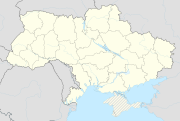Bakhchysarai
| Bakhchysarai | ||
| Бахчисарай | ||

|
|
|
| Basic data | ||
|---|---|---|
| Oblast : | Autonomous Republic of Crimea | |
| Rajon : | Bakhchysarai Raion | |
| Height : | no information | |
| Area : | Information is missing | |
| Residents : | 26,700 (2004) | |
| Postcodes : | 98400 | |
| Area code : | +380 6554 | |
| Geographic location : | 44 ° 46 ' N , 33 ° 51' E | |
| KOATUU : | 120410100 | |
| Administrative structure : | 1 city, 1 urban-type settlement | |
| Mayor : | Dmytro Kretow | |
| Address: | вул. Сімферопольска 14 98400 м. Бахчисарай |
|
| Statistical information | ||
|
|
||
Bakhchysaraj ( Ukrainian and Russian Бахчисарай / Bakhchisarai ; Crimean Tatar Bağçasaray , Tatar analogous to the Palace of the Garden ) is a Tatar city in the Autonomous Republic of Crimea , about 30 km from Simferopol .
geography
In Bakhchysarai stands the Khan Palace , from which the Crimean Khanate was once ruled. The building complex, which Iranian, Turkish, Russian and Ukrainian masters were involved in building from the 16th to the 18th centuries, shows a mixture of different architectural styles . It houses the fountain of tears, which Alexander Pushkin sang about in a famous poem. The fountain by Bakhchisarai has been set to music by various Russian composers, for example as a cantata by Arensky (1899) and as a ballet by Assafjew (1933/34).
Not far from Bakhchysarai is the cave city of Chufut-Kale ( Çufut Qale , Чуфут Кале), which was founded in the 10th century. There is also a cave monastery founded in the 8th century by monks from Byzantium on the stone plateau of Tschufut-Kale .
history
The place itself was mentioned for the first time in 1502 and in 1532 it became the seat of Khan Sahib I. Giray and thus the capital of the Khanate of Crimea . Among other things, the Ismi-chan mosque was built here. After the Russo-Turkish War in 1783, it was downgraded to a normal settlement, and it was not until 1926 that it regained city status.
Until the deportation of the Crimean Tatars under Stalin on May 18, 1944, Bakhchysarai was one of three places - alongside Karasubazar (now Bilohirsk ) and Alushta - with a Crimean Tatar majority. The Crimean Tatars deported in 1944 were allowed to return in 1989. Seventy years later, after Russia annexed Crimea in March 2014, the Crimean Tatars are being persecuted again. The city's former mayor, Ilmi Umerow , was admitted to a psychiatric clinic.
In administrative terms, it is divided into the urban-type Nautschnyj settlement in addition to the actual city .
sons and daughters of the town
- İsmail Gasprinski (1851–1914), Crimean Tatar educator, publisher and politician
- Edige Mustafa Kirimal (1911–1980), Turkish politician of Crimean Tatar origin
- Mustafa Abdülcemil Kirimoglu (* 1943), Ukrainian politician and human rights activist of Crimean Tatar origin
photos
Khan Palace: Inner courtyard with the Great Chan Mosque
Khan Palace: Dīwān Hall
Web links
Individual evidence
- ↑ Cathrin Kahlweit: "Profile: Ilmi Umerov." In: Süddeutsche Zeitung , September 4, 2016.






